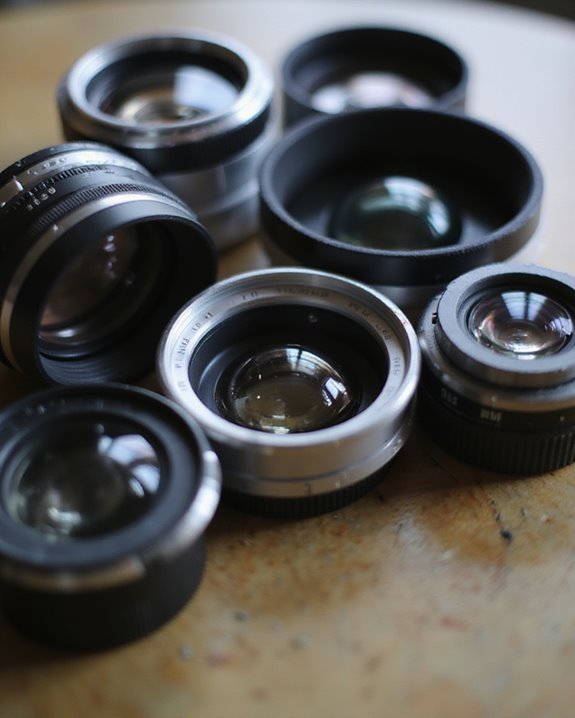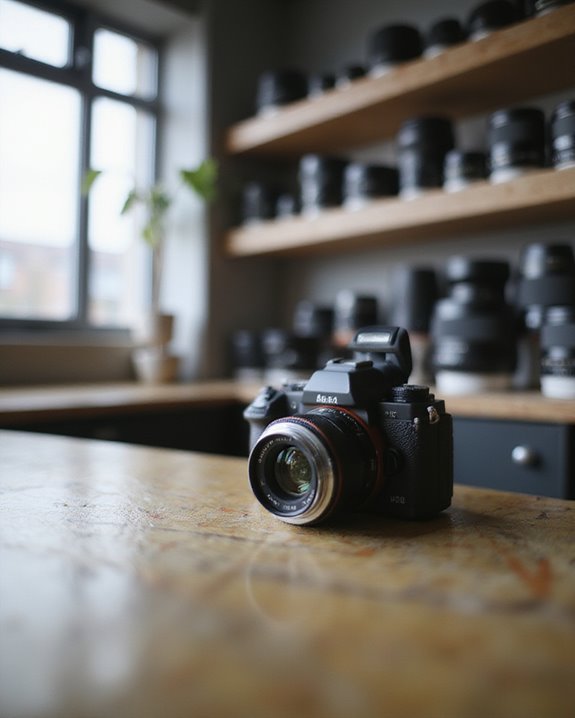Cameras utilize six main types of lenses: standard (50mm), wide-angle, telephoto, macro, zoom, and prime. Standard lenses replicate human vision, while wide-angle captures broader scenes for landscapes. Telephoto lenses magnify distant subjects for wildlife photography, and macro lenses specialize in extreme close-ups. Zoom lenses offer variable focal lengths for versatility, while prime lenses deliver superior image quality with fixed focal lengths. Understanding each type’s characteristics helps photographers select the ideal equipment for their specific needs.
Key Takeaways
- Standard lenses (50mm) provide a natural perspective similar to human vision for everyday photography.
- Wide-angle lenses capture broader scenes with focal lengths under 35mm, ideal for landscapes and architecture.
- Telephoto lenses magnify distant subjects with focal lengths above 85mm, perfect for wildlife and sports photography.
- Macro lenses enable extreme close-up photography, revealing intricate details invisible to the naked eye.
- Zoom lenses offer variable focal lengths in a single unit, providing flexibility without changing equipment.
Understanding the Six Main Camera Lens Types
The six main types of camera lenses serve distinct photographic purposes, each offering unique perspectives and capabilities for photographers. Standard lenses, with focal lengths around 50mm, provide a natural view similar to human vision, representing an early milestone in Lens Evolution. Wide-angle lenses capture broader scenes, making them ideal for landscapes and architecture. Telephoto lenses magnify distant subjects through longer focal lengths, essential for wildlife and sports photography. Macro lenses specialize in extreme close-ups, revealing intricate details invisible to the naked eye. Zoom lenses offer variable focal lengths for versatile shooting without changing equipment, a significant Type Innovation that revolutionized photography. Fisheye lenses create dramatic ultra-wide perspectives with distinctive barrel distortion, representing a creative departure from conventional optics that expanded artistic possibilities for photographers seeking unique visual statements. Additionally, premium telephoto zoom lenses with extended focal ranges enable professional wildlife and astronomy photography, further diversifying the options available to photographers.
Key Characteristics That Differentiate Camera Lenses
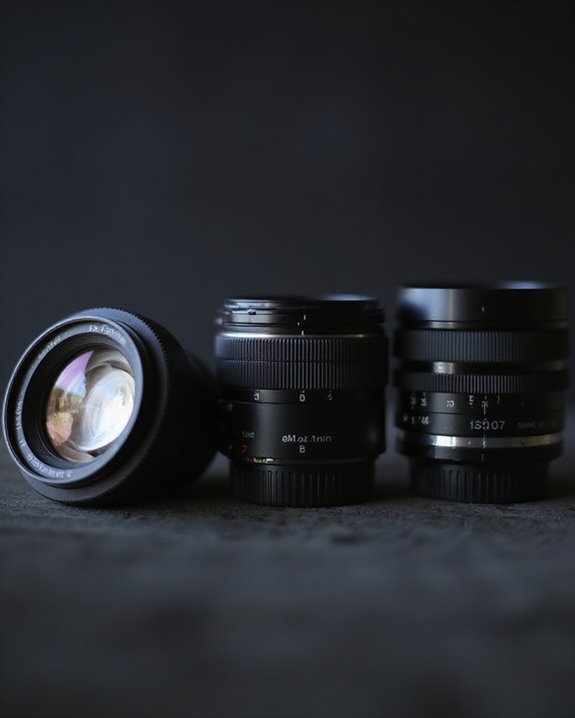
Camera lenses, while superficially similar in appearance, differ substantially through several key characteristics that photographers must consider when selecting equipment for specific shooting scenarios. The focal length determines the angle of view, with wide-angle lenses (16mm) exaggerating spatial relationships while telephoto lenses (200mm+) compress backgrounds. Aperture range affects light gathering capability and depth of field control, with faster lenses (f/1.4-f/2.8) excelling in low-light conditions. Optical design incorporates specialized technologies like aspherical elements that reduce distortion and chromatic aberration, particularly in wide-angle and zoom configurations. Advanced coating technologies minimize flare and ghosting when shooting toward light sources, improving contrast and color accuracy. Additional differentiating factors include weather-sealing capabilities, autofocus systems, weight distribution, and specialized features designed for specific photographic applications like macro photography or architectural work. Lens capabilities such as image stabilization and build quality further influence performance in diverse environments.
Matching Lens Types to Photography Styles
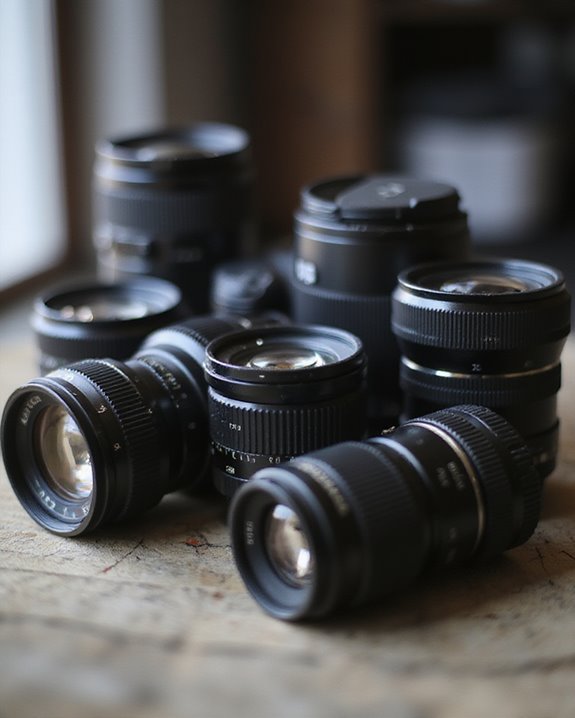
Selecting the right lens for specific photographic applications dramatically enhances image quality and creative possibilities, making the relationship between lens types and photography styles a fundamental consideration for photographers at every skill level. Ideal Lens Pairings begin with prime lenses (50mm, 85mm) for portrait photography, providing exceptional sharpness and wide apertures that create pleasing background blur. Landscape photographers typically benefit from zoom lenses, which offer compositional flexibility without changing equipment. Style Trends indicate macro lenses excel at close-up nature photography, while telephoto options (70-200mm) prove essential for sports and wildlife. Wide-angle lenses (14-35mm) capture expansive landscapes and architectural scenes, and standard lenses like the versatile 50mm serve everyday photography needs. Super telephoto lenses (300mm+) remain specialized tools for extreme distance work. Additionally, high-power super-telephoto lenses (500mm/1000mm) are invaluable for wildlife and sports photography when long reach is required extreme reach.
How to Select the Perfect Lens for Your Camera
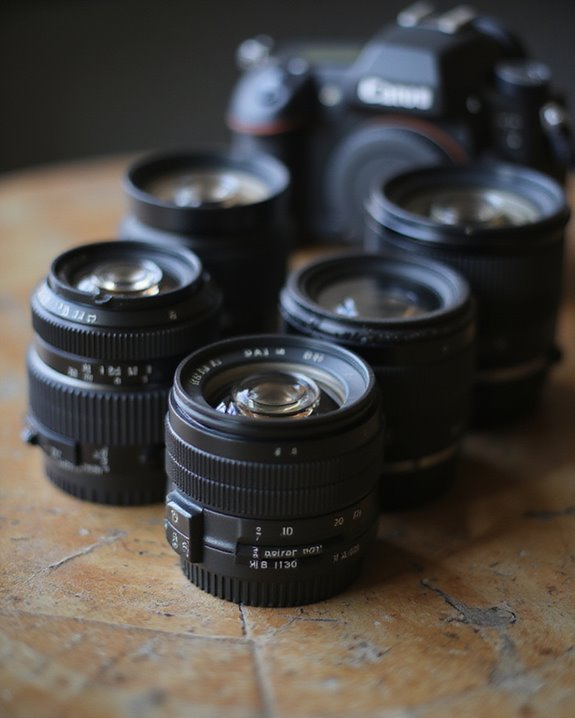
When photographers approach the task of lens selection, they must consider several critical factors that ultimately determine image quality, creative flexibility, and overall satisfaction with their equipment investment. Understanding focal length requirements based on shooting style is paramount, with wide-angle options for landscapes and telephoto lengths for distant subjects. Camera compatibility presents another essential consideration, as mount types, sensor sizes, and adapter possibilities greatly impact performance and usability. Budget Strategies involve balancing initial investment against long-term needs, with entry-level primes offering excellent value for beginners while professionals might prioritize weather-sealed zooms with constant apertures. Market Trends indicate growing interest in lightweight mirrorless-native lenses, third-party alternatives that offer competitive features at lower price points, and versatile zoom ranges that minimize the need for frequent lens changes.
Essential Maintenance Tips for Extending Lens Lifespan
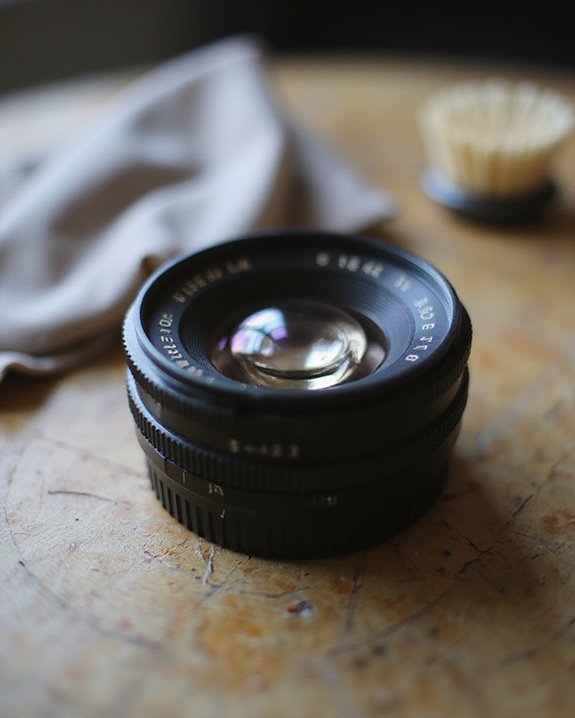
Proper maintenance forms the cornerstone of lens longevity, often extending the functional lifespan of photographic equipment by years when implemented consistently. Photographers should establish regular Cleaning Techniques, beginning with air blowers to remove loose particles, followed by gentle brushing and microfiber cloth application for stubborn smudges. When deeper cleaning is necessary, alcohol-based solutions prove effective without damaging delicate lens coatings.
Effective Storage Methods involve keeping lenses in cushioned cases with both front and rear caps securely attached when not in use. Environmental factors greatly impact lens condition, necessitating storage in dry environments with moderate temperatures. Professional photographers typically implement scheduled maintenance routines, inspecting equipment before and after shoots, while limiting unnecessary lens changes to minimize dust exposure during field operations.
Frequently Asked Questions
Can Smartphone Lenses Truly Replace DSLR or Mirrorless Camera Lenses?
Smartphone lenses cannot fully replace DSLR or mirrorless camera lenses. Despite computational advancements, physical limitations in sensor size and true optical zoom capabilities prevent smartphones from matching the versatility and quality of dedicated camera systems.
How Do Vintage Lenses Perform on Modern Digital Cameras?
Vintage lenses on modern digital cameras require adapters and offer unique optical aberrations. They produce distinctive character, often exhibiting softness, vignetting, and unique bokeh patterns that many photographers find aesthetically appealing despite technical limitations.
Is Lens Rental a Cost-Effective Alternative to Purchasing Expensive Lenses?
Why spend thousands on gear collecting dust? Lens rental offers substantial rental economics for photographers, providing budget flexibility while eliminating upfront costs, maintenance concerns, and depreciation losses compared to purchasing expensive lenses they may rarely use.
How Significantly Does Lens Choice Affect Post-Processing Requirements?
Lens choice greatly impacts post-processing requirements. Different lenses introduce specific optical characteristics requiring varied editing needs, with wide angles demanding distortion correction while prime lenses typically require less extensive post-processing due to superior optical quality.
Can Third-Party Lenses Match the Quality of Manufacturer-Branded Options?
Modern third-party lenses often match or exceed manufacturer quality, with advanced optics and build standards. However, lens compatibility may be less reliable, and warranty differences typically favor brand-name options with more extensive coverage.

